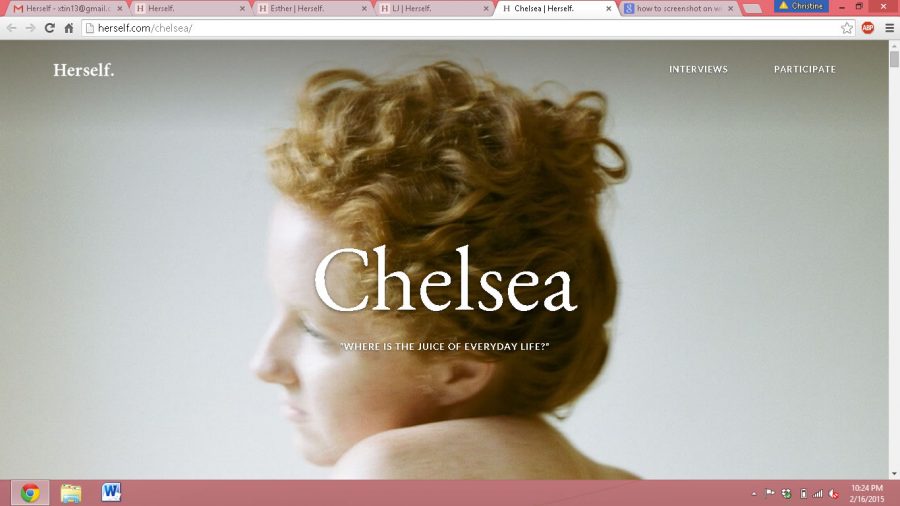
By CHRISTINE SMET
Opinion Editor
As 2015 began, there were quite a few articles circulating online about how 2014 was such a great year for feminism, most of which had Emma Watson pictures as their thumbnails, and most of which, I did not bother to read. Because to me and many others, 2014 was a year of some change but not enough, a year for mainstream feminism – feminism that focuses solely on dismantling patriarchal ideals yet upholds whiteness and heteronormativity. It was the year when mainstream feminists praised Emma Watson’s “He for She” speech, Hilary Clinton’s politics, Lena Dunham’s book and Jennifer Lawrence’s unapologetic attitude while simultaneously dismissing the likes of Jill Scott, Malala and Jennifer Laude and sexualizing Beyoncé and Nicki Minaj.
HerselfThat is why the website
Herselfby actress Caitlin Stasey is revitalizing, to say the least. Although not a revolutionary or new concept,
is nonetheless refreshing. The website seeks to empower women by giving them a space to present their bodies – in a primarily nude fashion thus far – and their stories because they, as individuals, want and choose to, in addition to finding support and encouragement in others’ experiences with topics typically considered too taboo to discuss publicly.
HerselfAs Stasey herself says on the website, “
Herselfis a gesture to women for women by women; a chance to witness the female form in all its honesty without the burden of the male gaze, without the burden of appealing to anyone. These women are simply & courageously existing, immortalized within these photos. Within their words, their experiences and stories are offered on
in the hopes of encouraging solidarity – that maybe we as women will take comfort in the triumphs of others rather than reveling in each other’s defeats. Let us reclaim our bodies. Let us take them back from those who seek to profit from our insecurity.”
HerselfWhy is
so special? Well, for starters, it is premised on empowerment. That means that women, for once, are freely able to be who they choose to be: free of standards, restrictions and pressures. They are put in control of their own stories and their own images.
They tell their stories because they want to, because they can resonate with others, because talking about it allows them to love and accept themselves. They show their nude, unretouched bodies because that is what they desire. Their unclothed forms exist outside of sexual spheres and are theirs to disclose to the public.
They tell their stories and show their bodies in conjunction because their bodies are connected to who they are as living, breathing organisms. They are not sexual objects for someone else’s viewing pleasure, meaning that every time a person says that posting nudes online allows them to be sexualized, it does not matter even a bit because they did what they wanted with their bodies and their choices should never have to be conditioned on another’s thoughts, values or beliefs.
HerselfSecondly,
Herselfis not just for white cisgender women:
is inclusive. If one takes a look at the front page of the website, one sees a collection of women with different body types, different skin colors, different views, different gender and sexual identities and different backgrounds. In fact, if one reads the questions that each interviewee answers, the questions seem purposefully open-ended to allow for and encourage various viewpoints.
For example, interviewees answer questions, such as “What does the word ‘woman’ mean to you?,” “Have you ever been in a position where your sexuality was used against you?,” “Have you ever been physically or verbally threatened because of your appearance?” and “Can you remember any key moments in your formative years that shaped you?” These questions allow participants to identify how they choose to share the experiences that are important to them and them alone. That means that women of color, who are too often seen as solely sexual objects, become more than that. That means that queer and transwomen have a place to proudly display their bodies as neutral, not weird or unnatural as others would make them out to be. There is even a catch-all question at the end as to not foreclose necessary remarks.
HerselfThird,
is for solidarity; not the solidarity where every woman decides to join a universal movement against the patriarchy; rather, solidarity in. One can empower oneself by viewing others’ images or reading others’ stories.
Solidarity, in this case, means knowing that you are not crazy or alone for feeling a certain way or wanting certain things. It means you can look to others who are like you in the slightest way and feel affirmation and support for who you are as an individual. In other words, by seeing someone else empower themselves, you can find the hope to do the same.
HerselfCaitlin Stasey’s website
, along with the accompanying opportunity for empowerment, is nothing new to feminism. But it is a welcome reminder that feminism is a multidimensional movement shared by many people with a multiplicity of beliefs. Ignoring any of those facets while striving for gender equality just feeds other forms of systemic and structural oppression.














